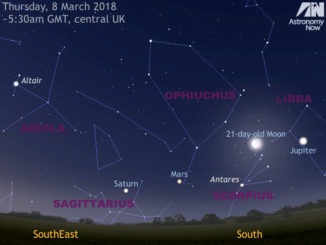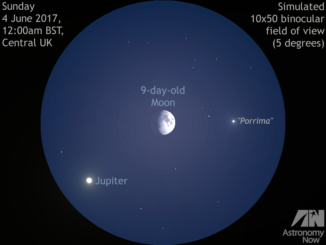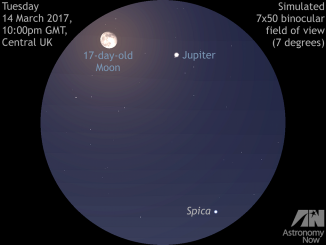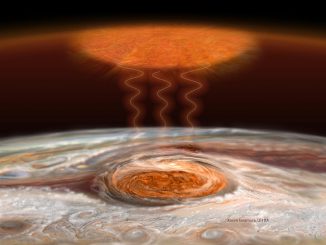
GRS


First quarter Moon meets Jupiter and Spica in the evening sky
Observer’s in the UK and Western Europe should look low to the southwest an hour after sunset on Friday, 30 June to glimpse the almost first quarter Moon a low-power binocular field of view to the right of Jupiter in bright twilight. The following night finds the waxing gibbous Moon forming a near isosceles triangle with the planet and first-magnitude star Spica in Virgo.

See the Moon hide double star Porrima then get close to Jupiter on 3—4 June
Jupiter now lies highest in the UK sky at sunset, but the Solar System’s largest planet and its four bright Galilean moons still provide plenty of observable events during June, as we reveal. If you’re uncertain which evening ‘star’ is Jupiter, the Moon conveniently passes by on the night of 3—4 June, a time when European skywatchers can also see the Moon occult (hide) bright double star Porrima.

Don’t miss Jupiter’s moons and Great Red Spot during May
Despite more than seven weeks having passed since opposition, the Solar System’s largest planet Jupiter is still big and bright in the UK evening sky of May, highest in the south around 10pm BST. Find out about the phenomena of Jupiter and its moons that you can see from the British Isles for the remainder of the month, starting with a transit of Jupiter’s Great Red Spot on 19 May.

See the Moon and Jupiter get close on 7 May
Observers with a clear sky to the south as darkness falls on Sunday 7 May can see the 12-day-old waxing gibbous Moon and planet Jupiter separated by little more than twice the width of a full Moon. For telescope owners in the UK, this is a night where you can also see Jupiter’s Great Red Spot and the planet’s four large Galilean moons.

Get ready to view planet Jupiter at its best
Jupiter, the Solar System’s largest planet, reaches opposition on the evening of 7 April and lies closest to Earth for 2017 the following night. Don’t miss the 14-day-old Moon passing close by on the night of 10 April too. Here’s our comprehensive guide to what to see on Jupiter and phenomena of its bright moons for the month ahead.

See the Moon and largest planet Jupiter get close on 14 March
Jupiter is now less than a month from opposition (7 April), so it’s very much open season for the Solar System’s largest planet. If you’re unsure where to find it, the rising 17-day-old waning gibbous Moon passes just two degrees from Jupiter on the UK evening of 14 March. Virgo’s brightest star, first-magnitude Spica, makes it a great binocular triumvirate.

The Moon, Jupiter and star Spica line up at dawn on 19 January
Before sunrise on Thursday 19 January, observers in Western Europe can see an interesting celestial conjunction in the southern sky. At about 6am local time, the waning gibbous Moon, largest planet Jupiter and Spica — the brightest star in the constellation of Virgo — all lie in a line encompassed by the field of view of a typical 7x or 8x binocular.

Waning crescent Moon joins Jupiter in the dawn sky of 25 November
Around 6:30am GMT on Friday 25 November, as nautical twilight starts for the centre of the UK, the 25-day-old waning crescent Moon lies just 2½ degrees away from largest planet Jupiter low in the southeastern sky. This juxtaposition of the two brightest objects in the dawn sky will be nicely framed in a typical binocular.

Jupiter’s Great Red Spot heats planet’s upper atmosphere
Astronomers from Boston University have discovered that Jupiter’s Great Red Spot (GRS) may provide the mysterious source of energy required to heat the planet’s upper atmosphere to the unusually high values observed. Heating in Jupiter’s atmosphere 500 miles above the GRS is thought to be caused by gravity waves and acoustic waves creating turbulent atmospheric flows.
